人教版七年级下册英语Unit5教案
- 格式:docx
- 大小:24.52 KB
- 文档页数:3
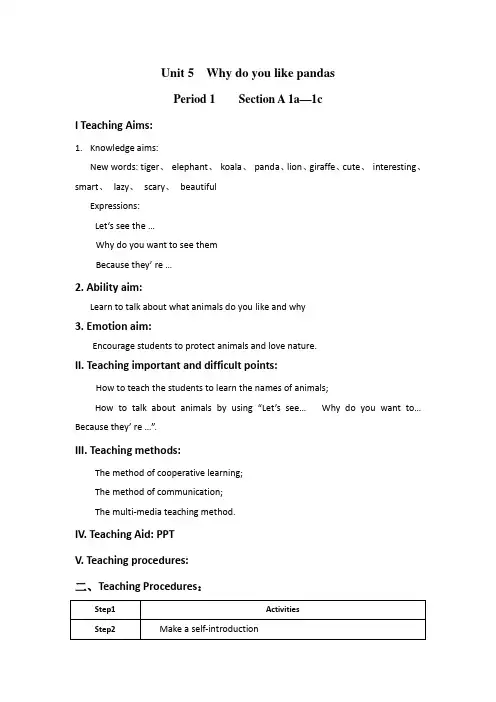
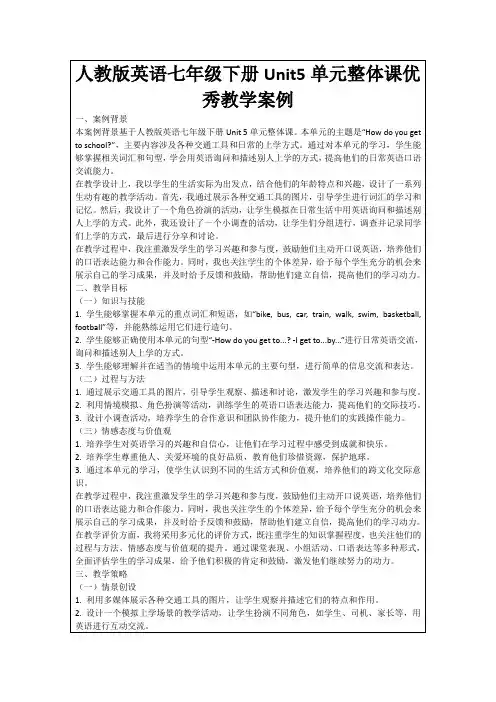
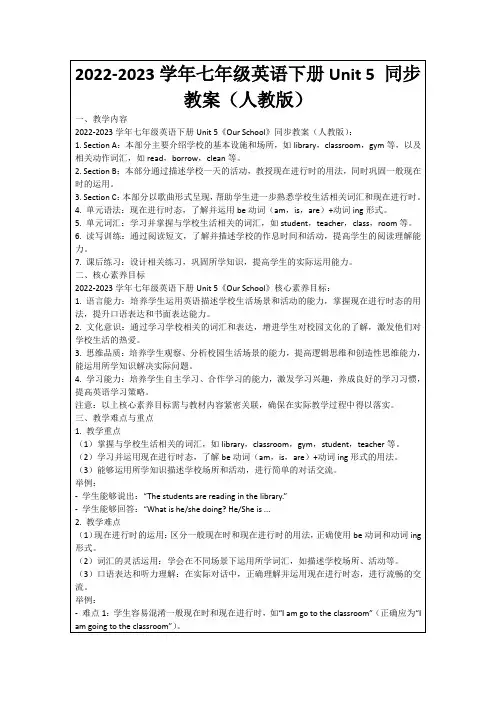
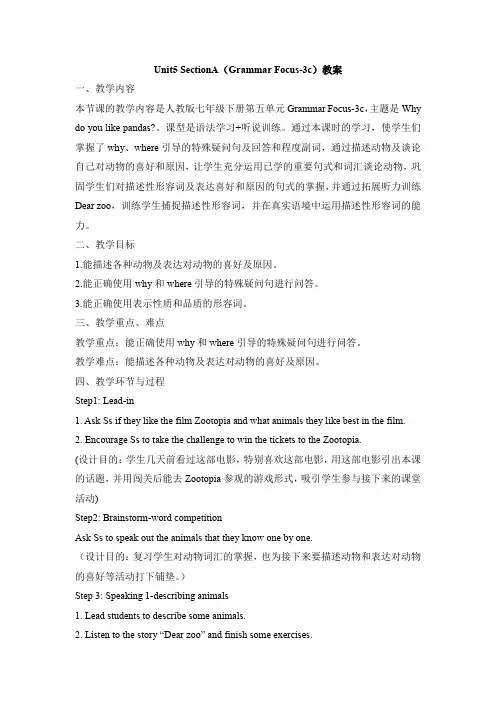
Unit5 SectionA(Grammar Focus-3c)教案一、教学内容本节课的教学内容是人教版七年级下册第五单元Grammar Focus-3c,主题是Why do you like pandas?。
课型是语法学习+听说训练。
通过本课时的学习,使学生们掌握了why、where引导的特殊疑问句及回答和程度副词,通过描述动物及谈论自己对动物的喜好和原因,让学生充分运用已学的重要句式和词汇谈论动物,巩固学生们对描述性形容词及表达喜好和原因的句式的掌握,并通过拓展听力训练Dear zoo,训练学生捕捉描述性形容词,并在真实语境中运用描述性形容词的能力。
二、教学目标1.能描述各种动物及表达对动物的喜好及原因。
2.能正确使用why和where引导的特殊疑问句进行问答。
3.能正确使用表示性质和品质的形容词。
三、教学重点、难点教学重点:能正确使用why和where引导的特殊疑问句进行问答。
教学难点:能描述各种动物及表达对动物的喜好及原因。
四、教学环节与过程Step1: Lead-in1. Ask Ss if they like the film Zootopia and what animals they like best in the film.2. Encourage Ss to take the challenge to win the tickets to the Zootopia.(设计目的:学生几天前看过这部电影,特别喜欢这部电影,用这部电影引出本课的话题,并用闯关后能去Zootopia参观的游戏形式,吸引学生参与接下来的课堂活动)Step2: Brainstorm-word competitionAsk Ss to speak out the animals that they know one by one.(设计目的:复习学生对动物词汇的掌握,也为接下来要描述动物和表达对动物的喜好等活动打下铺垫。
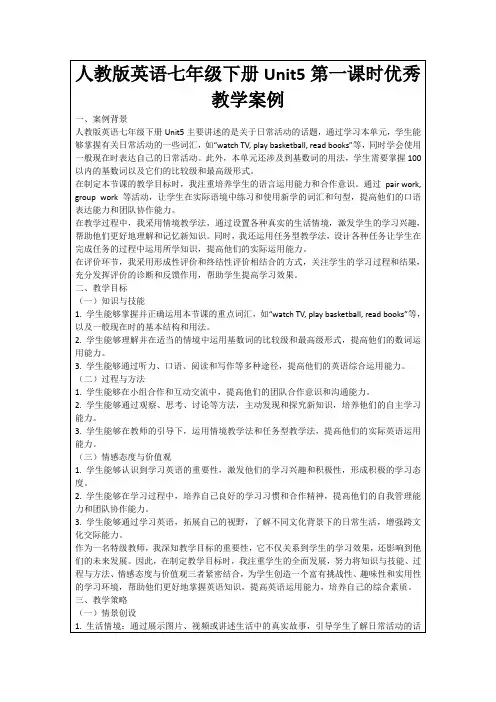
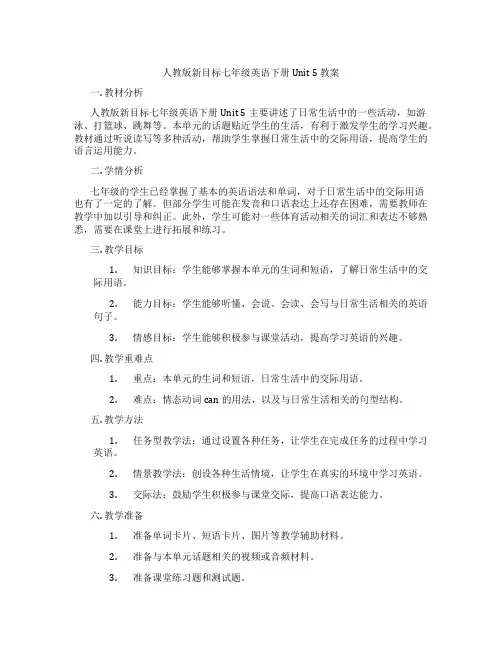
人教版新目标七年级英语下册 Unit 5 教案一. 教材分析人教版新目标七年级英语下册Unit 5主要讲述了日常生活中的一些活动,如游泳、打篮球、跳舞等。
本单元的话题贴近学生的生活,有利于激发学生的学习兴趣。
教材通过听说读写等多种活动,帮助学生掌握日常生活中的交际用语,提高学生的语言运用能力。
二. 学情分析七年级的学生已经掌握了基本的英语语法和单词,对于日常生活中的交际用语也有了一定的了解。
但部分学生可能在发音和口语表达上还存在困难,需要教师在教学中加以引导和纠正。
此外,学生可能对一些体育活动相关的词汇和表达不够熟悉,需要在课堂上进行拓展和练习。
三. 教学目标1.知识目标:学生能够掌握本单元的生词和短语,了解日常生活中的交际用语。
2.能力目标:学生能够听懂、会说、会读、会写与日常生活相关的英语句子。
3.情感目标:学生能够积极参与课堂活动,提高学习英语的兴趣。
四. 教学重难点1.重点:本单元的生词和短语,日常生活中的交际用语。
2.难点:情态动词can的用法,以及与日常生活相关的句型结构。
五. 教学方法1.任务型教学法:通过设置各种任务,让学生在完成任务的过程中学习英语。
2.情景教学法:创设各种生活情境,让学生在真实的环境中学习英语。
3.交际法:鼓励学生积极参与课堂交际,提高口语表达能力。
六. 教学准备1.准备单词卡片、短语卡片、图片等教学辅助材料。
2.准备与本单元话题相关的视频或音频材料。
3.准备课堂练习题和测试题。
七. 教学过程1.导入(5分钟)利用图片或视频引导学生谈论日常生活中喜欢的活动,引出本课话题。
2.呈现(10分钟)老师展示本课的生词和短语,让学生朗读并解释其意思。
同时,老师用情态动词can提问,引导学生回答。
3.操练(15分钟)学生分角色扮演,用情态动词can进行问答。
老师巡回指导,纠正发音和表达错误。
4.巩固(10分钟)学生完成课堂练习题,老师及时批改和讲解。
5.拓展(5分钟)老师引导学生谈论更多关于日常活动的表达,如游泳、打篮球、跳舞等。
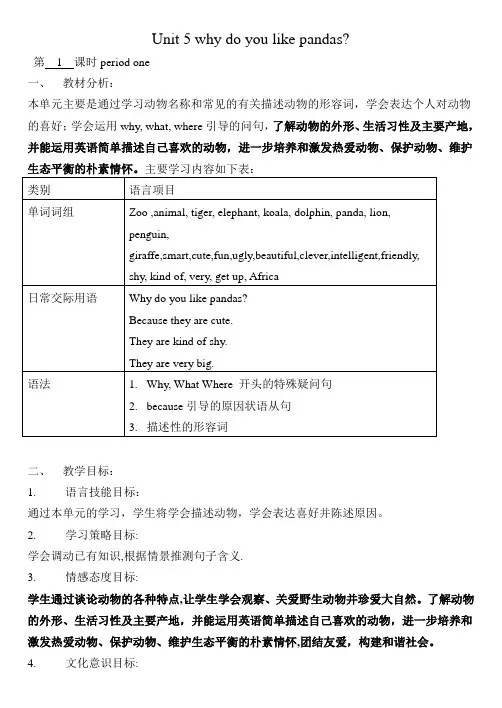
Unit 5 why do you like pandas?
第1课时period one
一、教材分析:
本单元主要是通过学习动物名称和常见的有关描述动物的形容词,学会表达个人对动物的喜好;学会运用why, what, where引导的问句,了解动物的外形、生活习性及主要产地,并能运用英语简单描述自己喜欢的动物,进一步培养和激发热爱动物、保护动物、维护生态平衡的朴素情怀。
主要学习内容如下表:
二、教学目标:
1.语言技能目标:
通过本单元的学习,学生将学会描述动物,学会表达喜好并陈述原因。
2.学习策略目标:
学会调动已有知识,根据情景推测句子含义.
3.情感态度目标:
学生通过谈论动物的各种特点,让学生学会观察、关爱野生动物并珍爱大自然。
了解动物的外形、生活习性及主要产地,并能运用英语简单描述自己喜欢的动物,进一步培养和激发热爱动物、保护动物、维护生态平衡的朴素情怀,团结友爱,构建和谐社会。
4.文化意识目标:
了解各种动物的特性及它们的分布点。
第2课时
第3课时
第4课时
第5课时
第6课时
第7课时。
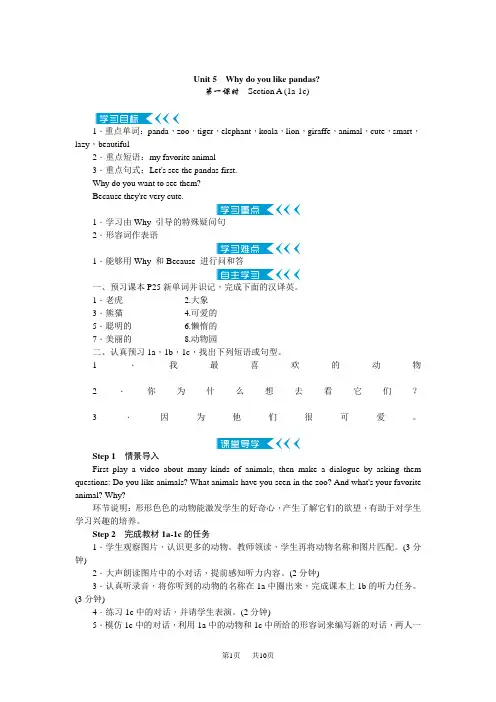
Unit 5Why do you like pandas?第一课时Section A (1a-1c)1.重点单词:panda,zoo,tiger,elephant,koala,lion,giraffe,animal,cute,smart,lazy,beautiful2.重点短语:my favorite animal3.重点句式:Let's see the pandas first.Why do you want to see them?Because they're very cute.1.学习由Why 引导的特殊疑问句2.形容词作表语1.能够用Why 和Because 进行问和答一、预习课本P25新单词并识记,完成下面的汉译英。
1.老虎____________ 2.大象____________3.熊猫____________ 4.可爱的____________5.聪明的__________ 6.懒惰的__________7.美丽的__________8.动物园__________二、认真预习1a,1b,1c,找出下列短语或句型。
1.我最喜欢的动物________________________________________________________________________ 2.你为什么想去看它们?________________________________________________________________________ 3.因为他们很可爱。
________________________________________________________________________Step 1情景导入First play a video about many kinds of animals, then make a dialogue by asking them questions: Do you like animals? What animals have you seen in the zoo? And what's your favorite animal? Why?环节说明:形形色色的动物能激发学生的好奇心,产生了解它们的欲望,有助于对学生学习兴趣的培养。
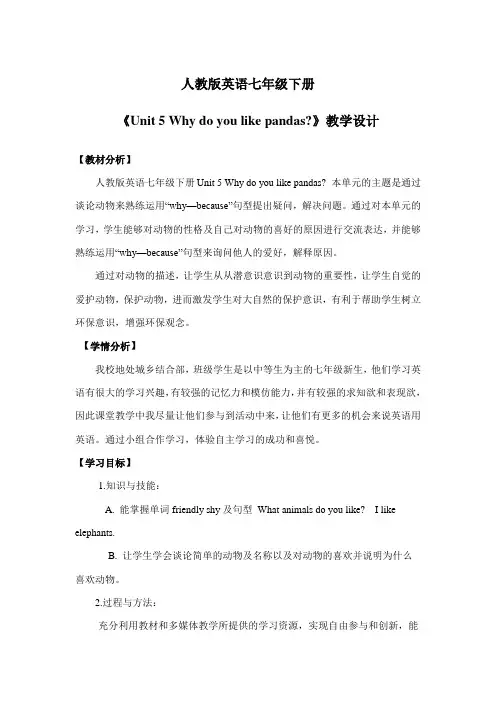
人教版英语七年级下册《Unit 5 Why do you like pandas?》教学设计【教材分析】人教版英语七年级下册Unit 5 Why do you like pandas? 本单元的主题是通过谈论动物来熟练运用“why—because”句型提出疑问,解决问题。
通过对本单元的学习,学生能够对动物的性格及自己对动物的喜好的原因进行交流表达,并能够熟练运用“why—because”句型来询问他人的爱好,解释原因。
通过对动物的描述,让学生从从潜意识意识到动物的重要性,让学生自觉的爱护动物,保护动物,进而激发学生对大自然的保护意识,有利于帮助学生树立环保意识,增强环保观念。
【学情分析】我校地处城乡结合部,班级学生是以中等生为主的七年级新生,他们学习英语有很大的学习兴趣,有较强的记忆力和模仿能力,并有较强的求知欲和表现欲,因此课堂教学中我尽量让他们参与到活动中来,让他们有更多的机会来说英语用英语。
通过小组合作学习,体验自主学习的成功和喜悦。
【学习目标】1.知识与技能:A. 能掌握单词friendly shy及句型What animals do you like? I like elephants.B. 让学生学会谈论简单的动物及名称以及对动物的喜欢并说明为什么喜欢动物。
2.过程与方法:充分利用教材和多媒体教学所提供的学习资源,实现自由参与和创新,能主动与他人交流,在鼓励性评价中树立信心,在小组活动中积极参与合作,从而意识到交流对于学习英语的重要意义。
3.情感态度与价值观:通过本课学习,使学生有兴趣听说英语、做游戏,敢于开口,乐于模仿,恰当使用英语谈论简单的动物及名称以及对动物的喜欢并说明为什么喜欢动物,激发学生学习英语兴趣和保护环境的意识。
教学重点:让学生学习用形容词描述动物,从而说明自己喜欢某种动物的原因。
教学难点:让学生用句型What animals do you like? Why do you like ......? Because they are cute.等句型编对话。
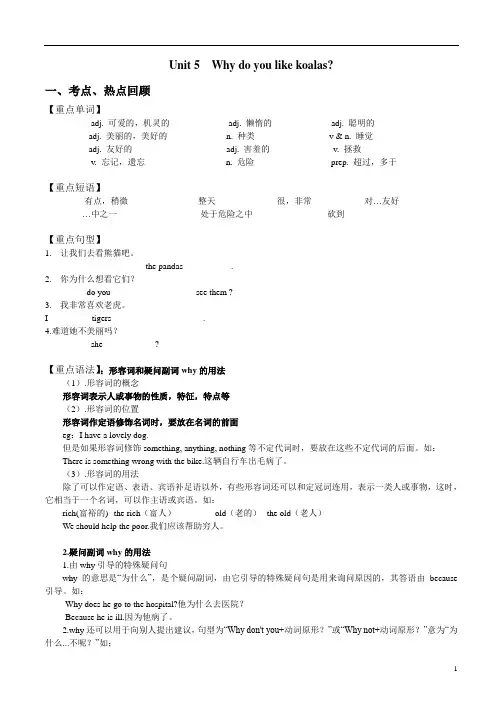
Unit 5 Why do you like koalas?一、考点、热点回顾【重点单词】__________ adj. 可爱的,机灵的__________ adj. 懒惰的__________ adj. 聪明的__________adj. 美丽的,美好的__________ n. 种类__________v & n. 睡觉__________adj. 友好的__________ adj. 害羞的___________ v. 拯救__________ v. 忘记,遗忘__________ n. 危险___________ prep. 超过,多于【重点短语】________ 有点,稍微____________ 整天_________ 很,非常_________ 对…友好________ …中之一_____________ 处于危险之中____________ 砍到【重点句型】1.让我们去看熊猫吧。
____________ __________ the pandas___________.2.你为什么想看它们?_________ do you _________ _________ see them ?3.我非常喜欢老虎。
I _________ tigers __________ __________.4.难道她不美丽吗?__________ she ___________ ?【重点语法】:形容词和疑问副词why的用法(1).形容词的概念形容词表示人或事物的性质,特征,特点等(2).形容词的位置形容词作定语修饰名词时,要放在名词的前面eg:I have a lovely dog.但是如果形容词修饰something, anything, nothing等不定代词时,要放在这些不定代词的后面。
如:There is something wrong with the bike.这辆自行车出毛病了。
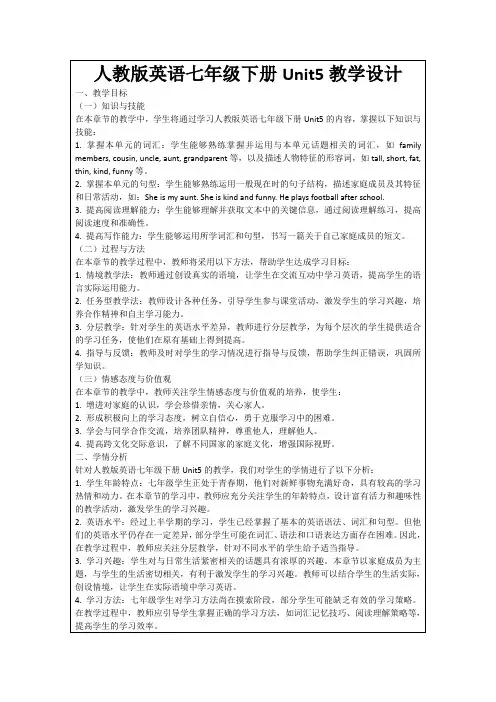
人教版七年级下册英语Unit 5 说课稿一. 教材分析人教版七年级下册英语Unit 5主要讲述了日常生活中的一些活动,如做家务、上学、看电影等。
本单元的核心词汇有housework, homework, watch, read, sports 等,同时本单元还涉及到一般现在时的用法。
通过本单元的学习,学生能够掌握日常生活中的一些基本表达,并能用英语描述自己的日常活动。
二. 学情分析七年级的学生已经具备了一定的英语基础,能够进行简单的英语交流。
但是,部分学生对于一般现在时的用法还不是很清楚,需要老师在教学中进行详细的解释和引导。
此外,学生在口语表达方面还存在一定的困难,需要老师提供更多的机会进行实践和锻炼。
三. 说教学目标1.知识目标:学生能够掌握Unit 5中的核心词汇和短语,理解一般现在时的用法。
2.能力目标:学生能够用英语描述自己的日常活动,进行简单的交流。
3.情感目标:通过学习,学生能够培养对英语的兴趣,增强学习的自信心。
四. 说教学重难点1.重点:学生能够掌握Unit 5中的核心词汇和短语,理解一般现在时的用法。
2.难点:学生能够运用一般现在时描述自己的日常活动,并进行口语交流。
五. 说教学方法与手段1.教学方法:采用任务型教学法,让学生在实际操作中掌握知识,提高能力。
2.教学手段:利用多媒体课件、图片、卡片等辅助教学,增加课堂的趣味性。
六. 说教学过程1.导入:通过展示图片,引导学生谈论自己喜欢的活动,引出本课主题。
2.新课呈现:通过多媒体课件,展示本课的核心词汇和短语,讲解一般现在时的用法。
3.操练:学生分组进行角色扮演,运用一般现在时描述自己的日常活动。
4.巩固:学生完成课堂练习,检测对知识的掌握情况。
5.拓展:引导学生谈论自己的梦想,用英语表达对未来生活的期望。
6.总结:对本课内容进行总结,强调一般现在时的用法。
七. 说板书设计板书设计如下:人教版七年级下册英语Unit 5核心词汇:housework, homework, watch, read, sports等一般现在时:主语 + 动词原形八. 说教学评价1.课堂参与度:观察学生在课堂上的参与情况,是否积极回答问题,参与讨论。
人教版七年级下册英语Unit 5大单元教学整体教学设计一. 教材分析人教版七年级下册英语Unit 5主要围绕“家庭成员”展开,通过介绍家庭成员的名称、职业和爱好等,让学生掌握一般现在时的表达方式。
教材通过丰富的图片、情景对话和任务型活动,激发学生的学习兴趣,培养学生运用英语进行交际的能力。
二. 学情分析七年级的学生已经掌握了基本的英语语法和词汇,具备一定的听说读写能力。
但部分学生对家庭成员的英文表达和用法还不够熟悉,需要在课堂上进行针对性训练。
此外,学生对英语学习的兴趣和动机有待进一步提高。
三. 教学目标1.知识目标:学生能够掌握家庭成员的英文表达,学会用一般现在时介绍家庭成员的名称、职业和爱好等。
2.能力目标:学生能够在日常生活中运用英语进行家庭成员的介绍,提高口语交际能力。
3.情感目标:学生能够培养对英语学习的兴趣,增进与同学之间的友谊。
四. 教学重难点1.重点:家庭成员的英文表达和一般现在时的运用。
2.难点:家庭成员词汇的拓展和一般现在时在不同情境下的运用。
五. 教学方法1.情境教学法:通过设定生活情境,让学生在实际语境中学习、运用英语。
2.任务型教学法:引导学生参与各种任务,提高学生的实践能力和合作意识。
3.游戏教学法:通过趣味游戏,激发学生的学习兴趣,巩固所学知识。
六. 教学准备1.教学课件:制作课件,包含图片、视频、任务型活动等。
2.教学道具:准备与家庭成员相关的实物道具,如家庭成员照片、角色卡片等。
3.教学资源:收集一些关于家庭成员的英文资料,如文章、歌曲等。
七. 教学过程1.导入(5分钟)利用趣味游戏“猜猜我是谁?”引导学生谈论家庭成员,激发学生的学习兴趣。
教师出示一些家庭成员的图片,让学生用中文进行介绍。
2.呈现(10分钟)教师展示Unit 5的课件,引导学生关注标题“家庭成员”。
通过展示教材中的图片和情景对话,让学生整体感知课文内容。
同时,教师用中文解释一般现在时的概念,为学生接下来的学习做好铺垫。